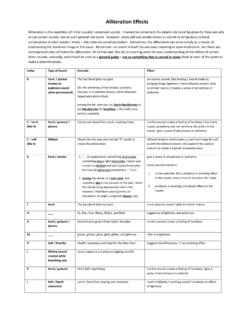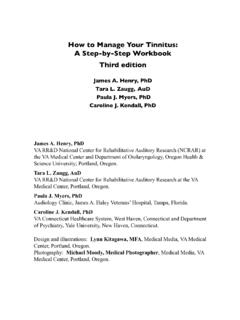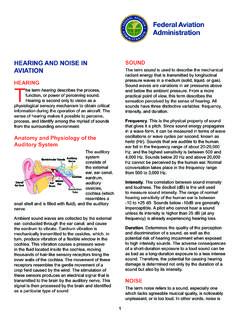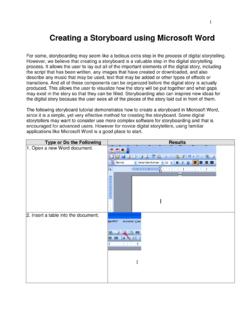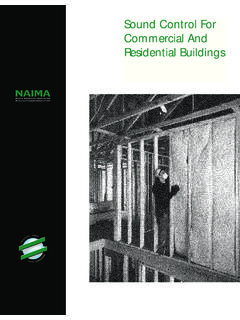Transcription of Film Langauge - Sound
1 Film LanguageSoundWelcomeFilm Language: Sound To develop the ability to use and understand film language associated with Sound . To demonstrate a variety of activities to help students gain deeper understanding of key Sound terminology. To review and critique a range of film titles to illustrate how and why Sound techniques are used. To facilitate understanding of theoretical concepts through practical filmmaking of the sessionFilm Language: Sound To understand the meanings of key Sound terminology. To explore the historical context of Sound . To practically apply theoretical understanding of Sound techniques. To identify the purpose of a range of Sound techniques. To identify and recognisethe features of key Sound outcomesFilm Language: Sound Key terms used in this session are featured in the Soundsection of the prompt card pack you received today.
2 This is yours to take back to class to use with Language prompt cardsFilm Language: SoundFilm Language: Sound Sound is everythingthat can be heard in a scene. The key elements that make up Sound in a film are: Location Sound Musical score/soundtrack Dialogue Sound effects Voiceover (if used). The absence of Sound in a scene can be also be is Sound ?Film Language: SoundMusic is used to heighten the emotionand drama of a scene. Audiences are experienced in decoding the style of music to interpret mood or genre, egscary music when a villain appears. music can:oDetermine the moodor genreof a filmoBuild up or release tensionoChange the emotional or physical status of a characteroSmooth out transitionsin an edit to allow a film to flow/link the scenes togetheroHighlight or code a theme or emotional impact of musicFilm Language: SoundA brief history of film soundFilm Language: SoundThe silent era When we think of early cinema we think of the silent era , which may be rather misleading as since the inception of film it has been inexorably linked with Sound .
3 In the early days, the technologies of the capture of moving images and Sound recording were being developed in tandem but synchronisationtook some time to of film Sound Thomas Edison, one of the early pioneers of cinema, is well known for his early film Fred Ott sSneeze produced in 1894. He is perhaps less well know for inventing the first Sound recording device, the Phonograph, years earlier in Ott sSneeze (1894)Film Language: SoundProperty of Edison Studios (1894) All rights reserved Synchronisingfilm and Sound In 1895, Edison began working with the Kinetophone the aim of which was synchronisedsound and vision. He engaged assistant William Kennedy Laurie Dickson who worked on a number of film Sound experiments. During the mid 1890s, Dickson produced a range of short films with synced Sound .
4 Sadly only one Experimental Sound Film (circa 1894)Property of Edison Studios (1894) All rights reserved Film Language: SoundEmerging technologies The major difficulty faced during this period was achieving Sound synchronisedwith on-screen imagery, so screening dens known as Nickelodeons often accompanied screenings with live music . Inventors of the day were racing to be the first to create a method of matching moving images with reliable era of inventionIn 1900 at the world fair in Paris (Exposition Universelle), three new devices were exhibited: Phonorama Chronophone Phono Cin ma Th were without problems, including the short recording time of the wax cylinders used (and later 12 inch discs), skipping and lack of Sound projection Edison had originally envisaged film viewing as a private activity and his early inventions were housed firstly in penny arcades and later in nickelodeons (1905-1915) where they were often accompanied by live music .
5 Cinemas really came into their own around 1915 when projection technology improved and films moved from nickelodeons to large movie palaces which employed musicians to create music and Sound effects to accompany Significant technological developments were made in 1919 by German inventors, Josef Engl, Joseph Massoleand Hans Vogt who developed synchronisedsound printed directly onto the film strip, and DrLee de Forest who had in 1906 patented the audiontube which could amplify Sound . In 1919 De Forest began to work extensively with film Sound and in 1922 he opened the De Forest PhonofilmCompany and produced a number of films with to the studios De Forest offered his technology to Universal and Paramount who thought Sound was a passing fad. In 1925, rival company Vitaphonealso tried to sell to Hollywood with no success until relatively small studio Warner Brothers decided to lease the technology.
6 Premiering the talkies Warner brothers launched a hugely successful premiere of Don Juan in 1926 which used the Sound technology to accompany the film with synchonisedmusic but it wasn t until 1927 that the first talkie The Jazz Singer was created. The Jazz Singer slipped in and out of silent mode and still made use of title cards, but once audiences had experienced not only synchronisedmusic but also synchroniseddialogue, Sound was here to Jazz Singer (1927)Film Language: SoundProperty of Warner Home Video Ltd (2007) All rights reserved Film language: SoundFilm Language: Sound The words spoken by characters within the scene. Dialogue can be used to establish character definition and relationships, and to provide a plot information and back-story. Both the content (words spoken) and the delivery (performance and mood) of dialogue is important for the development of characterisationand narrative within the film Language: Sound This is when an omniscient narrator or a character is heard talking over the images you are seeing on the screen.
7 Voiceovers are often used to provide back-story and either a subjective or objective perspective of the story as it unfolds. They are usually recorded in a Language: SoundVoiceover -Sunset Boulevard (1950) Film Language: SoundProperty of BFI (Collections) (2002) All rights reserved Diegetic and non-diegetic soundIn film language, Sound is divided into two terms: Diegetic Sound has a physical origin in the film world (ega character coughing or the radio playing) Non-diegetic Sound has no direct origin in the film world (egthe soundtrack or the voice of a narrator).Film Language: SoundDiegetic and non-diegetic soundIn a moment you will watch clips from Gilda andGravity. As you watch each of them, consider: How many types of Sound can you distinguish? Can you hear dialogue, Sound effects, music or silence?
8 Which of the sounds do you think may be diegetic(within the world of the film), or non-diegetic (external to the film world)?Film Language: SoundGilda (1946) Film Language: SoundProperty of Park Circus Limited (2011) All rights reserved Gravity (2013) Film Language: SoundProperty of Warner Home Video Ltd (2014) All rights reserved Absence of non-diegetic musicFilm Language: Sound As non-diegetic music is very much associated with mainstream cinema and the overt and deliberate manipulation of audience emotions, some realist filmmakers chose to avoid it as much as possible. The absence of non-diegetic music can therefore be used to make scenes seem more realistic, such as in The Blair Witch Blair Witch Project (1999) Film Language: SoundProperty of Lions Gate Home Entertainment UK Ltd (2010) All rights reserved Contrapuntal Sound Contrapuntal Sound strongly contrasts with the mood or tone of the scene.
9 Can you think of any examples of film scenes that use contrapuntal Sound ? In what type of scene would this technique be most commonly used? Watch the film clip on the next slide -what impact does it have on you, as the audience?Film Language: SoundContrapuntal Sound -Brazil (1985) Film Language: SoundProperty of Twentieth Century Fox Home Ent. (2003) All rights reserved Film Language: Sound Parallel Sound matches the mood or tone of the soundBrazil (1985) without soundProperty of Twentieth Century Fox Home Ent. (2003) All rights reserved Film Language: SoundBrazil (1985) with soundProperty of Twentieth Century Fox Home Ent. (2003) All rights reserved Film Language: SoundFilm Language: SoundExaggerated/Pleonastic Sound Directors often use exaggerated Sound to heighten emotion or meaning in a scene.
10 Using Sound in this way cansuggest an incoming threat before the audience sees it. It can be used to reinforce a character s threatening nature when theyare present on screen. It can also help to emphasisethe emotional impact of a specific action taking place on Sound Spider-man 2 (2004)Film Language: SoundProperty of Sony Pictures Home Entertainment (2009) All rights reserved Film Language: SoundUnmotivated Sound Sometimes directors will use Sound effects which don t logically match the actions on screen but do add to the emotional impact of a scene. A director mightuse a record scratching Sound to suggest a sudden mishap in a comedy film. An unmotivated swooshing noise is also common to emphasisea character turning their Sound Who Framed Roger Rabbit? (1998)Film Language: SoundProperty of Buena Vista Home Entertainment (2003) All rights reserved Film Language: SoundWorldising Worldising, a term coined by Sound designer Walter Murch, refers to the practice of recording production audio in a way which will best mimic how it might be heard in real Language: SoundWorldisingFor American Graffiti (1973), in which the events of an evening are linked by a radio broadcast to which the main characters are listening, Murchtook a clean recording of the broadcast and re-recorded as it played out through external speakers.
